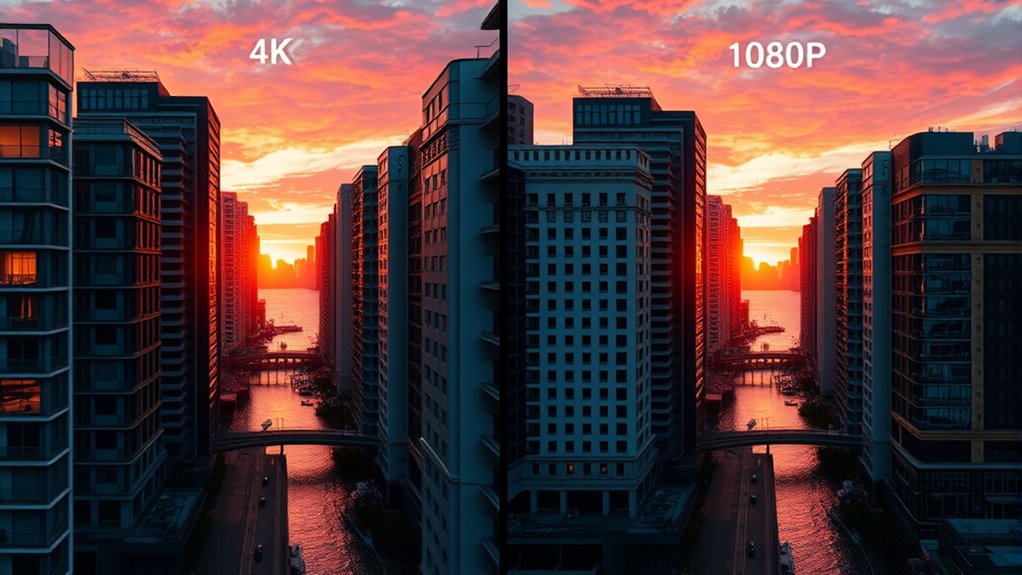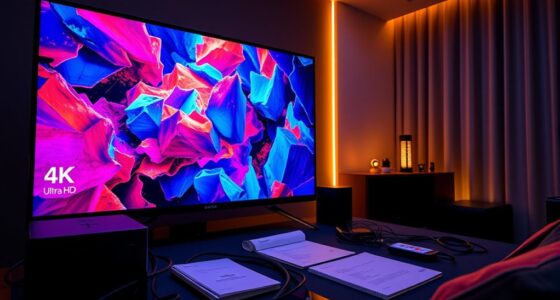4K offers about four times the pixels of 1080P, meaning sharper images with more detail and richer colors. It also supports higher frame rates and color depth, making visuals more lifelike—especially on large screens. However, it requires faster hardware, more storage, and higher bandwidth. While 4K markedly elevates quality, it also presents challenges. If you want to understand how these differences impact your projects, explore what’s behind the tech.
Key Takeaways
- 4K offers four times the pixel resolution of 1080P, resulting in sharper, more detailed images, especially on large screens.
- Higher color depth and wider gamuts in 4K deliver more vibrant, accurate colors compared to 1080P.
- 4K demands more powerful hardware, increased storage, and higher bandwidth for streaming and editing.
- Advanced content processing and AI upscaling make 4K visuals more accessible, even from lower-resolution sources.
- Compatibility and hardware limitations can impact the perceived quality benefits of 4K over 1080P.
The Technical Differences Between 4K and 1080P
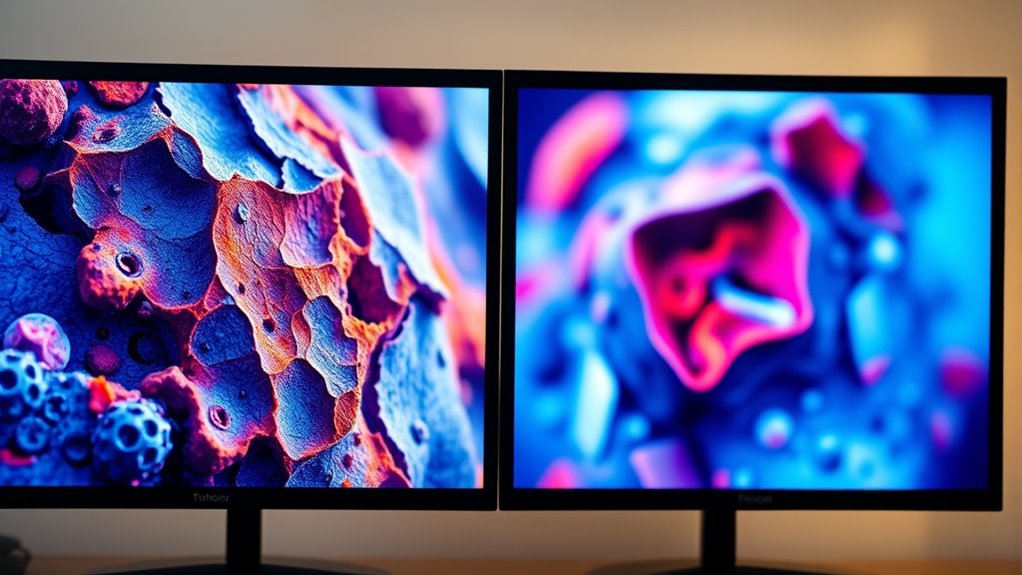
The primary technical difference between 4K and 1080P lies in their resolution, which determines the amount of detail each can display. 4K resolution, also known as Ultra HD, offers a pixel count of 3840 x 2160, totaling about four times as many pixels as 1080P’s 1920 x 1080. This increased pixel count allows for sharper images and more screen real estate. Additionally, 4K often supports higher color depth, which enhances color accuracy and richness, making images appear more vibrant. Refresh rates also tend to be higher in 4K displays, providing smoother motion during fast-paced scenes. These technical differences mean 4K can deliver more detailed, color-rich, and fluid visuals compared to 1080P, although both can vary depending on the specific device and settings. Understanding resolution is essential for appreciating the full advantages of 4K technology.
How Resolution Impacts Image Quality and Detail

Higher resolution directly enhances image quality by increasing the number of pixels, which allows you to see more detail and finer textures. With 4K, you get sharper images and better color accuracy, making scenes more vivid and lifelike. This is especially noticeable when you view content up close, where details are more apparent, and the difference between 1080p and 4K becomes clearer. As your viewing distance decreases, the benefits of higher resolution grow, revealing subtle textures and nuances that lower resolutions can’t provide. Resolution impacts how crisp and realistic your images appear, making 4K ideal for immersive viewing experiences. In summary, higher resolution improves detail, color accuracy, and overall image quality, especially when you’re closer to the screen. Additionally, resolution influences how well a projector handles contrast and color fidelity, further enhancing your viewing experience.
Storage, Bandwidth, and Processing Power Considerations
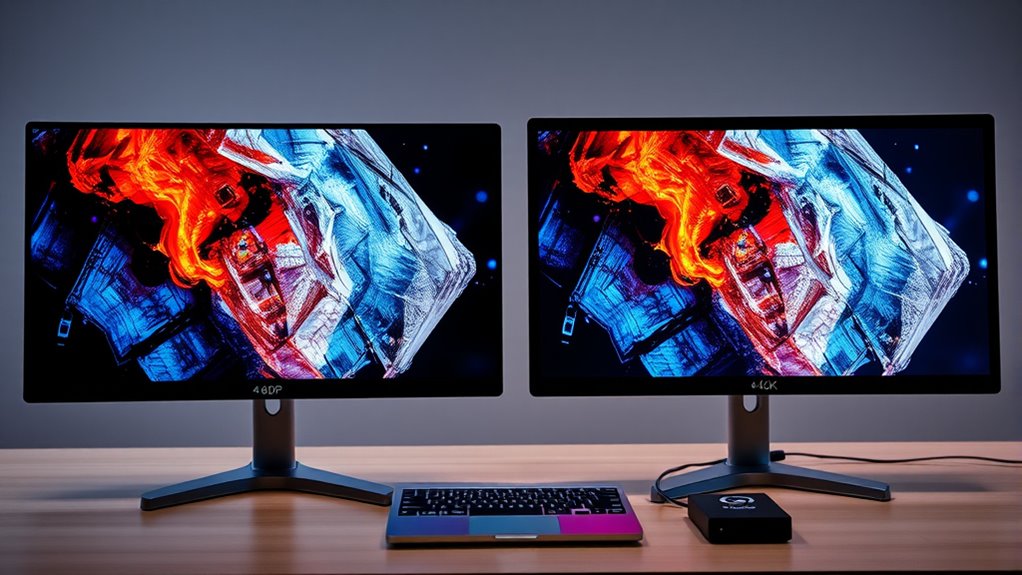
As you upgrade to 4K resolution, keep in mind that it demands considerably more storage space, higher bandwidth for streaming, and greater processing power to handle the increased data load. Advanced compression techniques help reduce file sizes without sacrificing color accuracy, but they still require robust hardware to decode and process smoothly. Streaming 4K content also needs faster internet connections to prevent buffering, especially when maintaining high quality. Additionally, your editing setup must have enough processing power to handle larger files and complex tasks like color grading and detail preservation. These requirements mean investing in better storage solutions, more powerful CPUs, and GPUs. Without these, even the best 4K footage can suffer from lag, artifacts, or poor quality reproduction. Incorporating media management tools can also optimize workflow and storage efficiency for high-resolution content.
The Real-World Benefits in Professional Content Creation
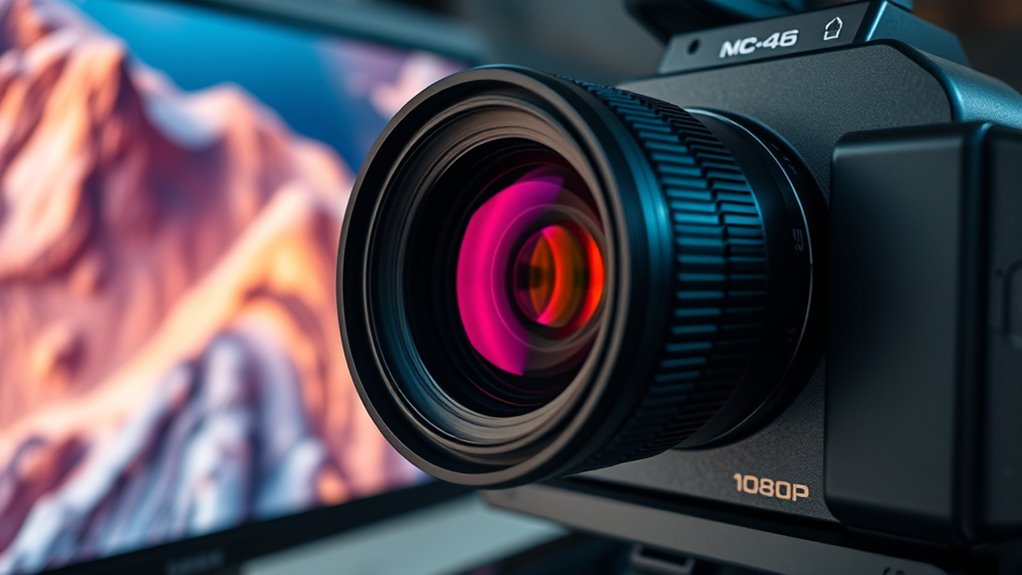
Upgrading to 4K resolution offers tangible advantages for professional content creators, boosting image clarity and detail that elevate the overall quality of productions. With 4K, you gain more flexibility during color grading, allowing you to refine tones and contrasts with greater precision. This higher resolution helps meet or exceed client expectations, especially for projects destined for large screens or high-end displays. The increased detail ensures your work looks sharper and more polished, enhancing visual storytelling. Additionally, 4K footage provides room for cropping or stabilizing shots without sacrificing quality, giving you more creative control. Moreover, Honda Tuning techniques like suspension upgrades and ECU remapping can be compared to the fine-tuning involved in optimizing video settings for maximum visual performance. Overall, adopting 4K elevates your craft, resulting in productions that stand out in clarity, color accuracy, and professionalism—key factors in satisfying clients and delivering impactful content.
Limitations and Challenges of Higher Resolutions

While 4K and other high resolutions offer significant benefits, they also introduce notable limitations and challenges. One major issue is display limitations; not all screens can support 4K properly, which can lead to reduced image quality or the need for costly upgrades. Hardware constraints also come into play—your devices, from graphics cards to processors, must be powerful enough to handle the increased processing demands. This can result in higher costs and potential performance bottlenecks during editing or playback. Additionally, higher resolutions demand more storage space and bandwidth, complicating workflows and increasing expenses. These challenges mean you’ll need to carefully assess your current hardware and display options before fully committing to higher resolutions. Crochet styles for locs can be used as a creative analogy for understanding layered technical requirements in high-resolution content.
When to Choose 4K Over 1080P for Your Projects
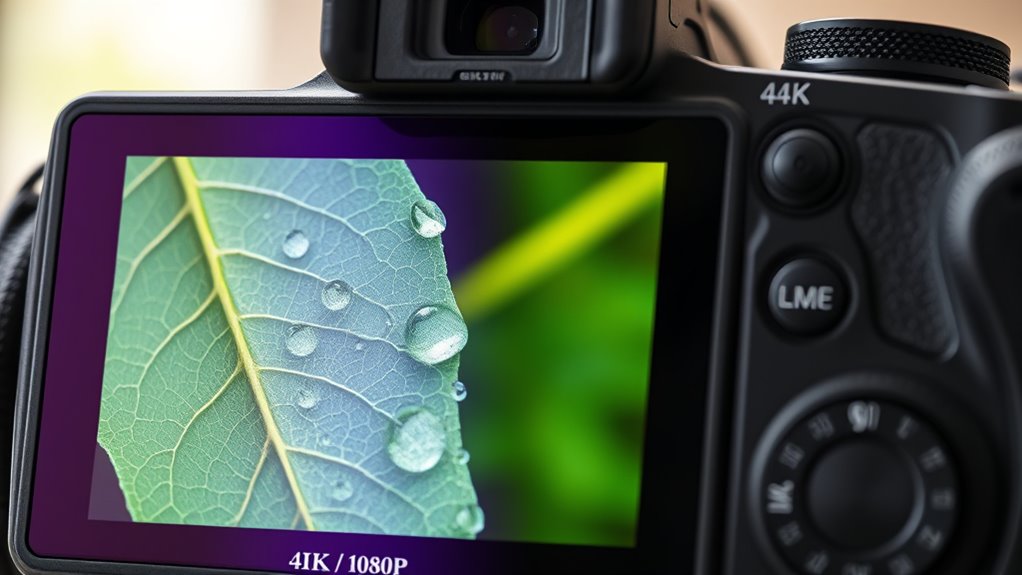
Choosing 4K over 1080P makes sense when your project demands higher detail, future-proofing, or professional quality. If you’re working on a project where camera ergonomics matter, 4K allows for better composition flexibility and cropping without losing clarity. It also benefits color grading techniques, giving you more latitude to enhance colors and adjust contrast in post-production. When you need sharp, detailed images that hold up on large screens or require extensive editing, 4K is the clear choice. Additionally, if you aim for a polished, cinematic look, the increased resolution supports higher-quality visuals. Consider your workflow, hardware capabilities, and the final display environment—opting for 4K makes your project more adaptable and professional-grade. It’s also important to recognize that image resolution can impact the overall perception and quality of your final product.
Future Trends and the Evolution of Display Resolutions
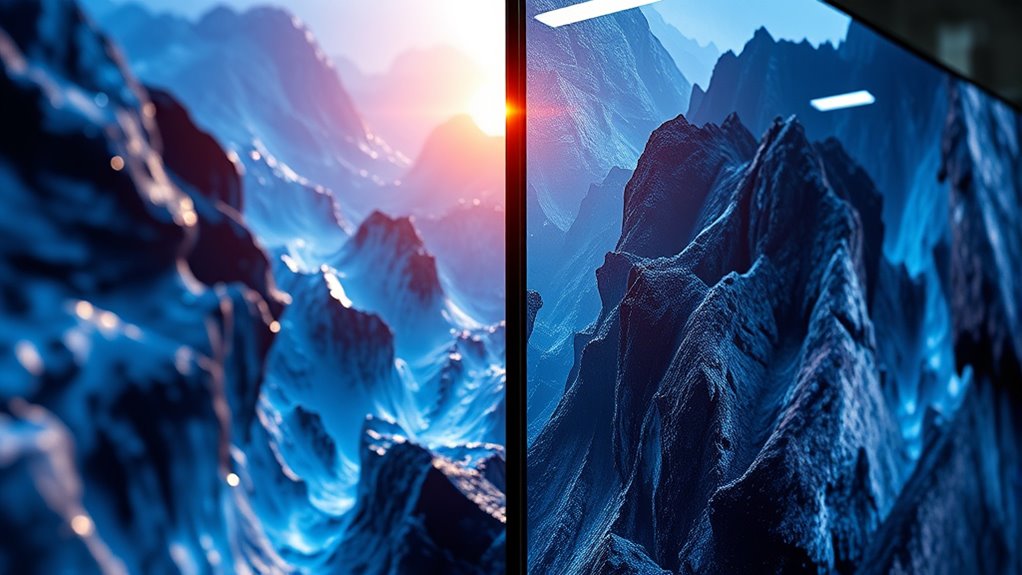
As display technology advances, you’ll notice emerging 8K standards pushing resolution limits even further. AI enhancement tools are also transforming how content appears, making visuals sharper and more realistic. These trends suggest that future screens will offer unprecedented clarity and immersive experiences.
Emerging 8K Standards
Emerging 8K standards are shaping the future of display technology by pushing the boundaries of resolution and image quality. As 8K screens become more common, focus shifts to maintaining accurate display calibration and color accuracy. Higher resolutions demand precise calibration to ensure images look sharp and true to life, especially when viewing detailed content. Future standards aim to improve color reproduction, minimizing distortions and enhancing realism. Manufacturers are developing new guidelines to optimize these displays, ensuring consistent performance across devices. To stay ahead, you’ll need to understand how these standards influence image clarity and color fidelity. Here’s a quick overview of key aspects:
| Aspect | Current Focus | Future Goals |
|---|---|---|
| Display calibration | Achieving uniform calibration | Automated calibration tools |
| Color accuracy | Enhancing color fidelity | Broader color gamuts |
| Resolution | Increasing pixel density | Seamless 8K content |
| Compatibility | Ensuring device interoperability | Standardized formats |
Additionally, ongoing innovations in content processing techniques are critical to fully leverage the capabilities of emerging display standards.
Impact of AI Enhancement
AI enhancement is revolutionizing display resolutions by enabling real-time image processing, upscaling, and calibration that were previously impossible. With AI enhancement, your devices can perform digital upscaling seamlessly, transforming lower-resolution content into near-4K quality instantly. This technology allows screens to enhance detail, reduce noise, and improve color accuracy dynamically, making even 1080p videos look sharper on large displays. As AI continues to evolve, expect smarter algorithms that adapt to your viewing environment, delivering more accurate and natural images. Future trends suggest AI enhancement will further blur the lines between native resolution and upscaled content, making high-quality visuals accessible regardless of original source limitations. This shift will profoundly impact how you experience entertainment, gaming, and professional visuals, emphasizing smarter, more efficient display technology.
Frequently Asked Questions
How Does 4K Impact Editing Workflows and Software Compatibility?
When editing in 4K, you’ll notice that it demands more robust hardware requirements, especially for smooth playback and rendering. It impacts your workflow by increasing load times and storage needs, but it also offers better detail for color grading and post-production precision. Make certain your software supports 4K editing seamlessly; otherwise, you might face compatibility issues. Upgrading hardware ensures you can handle the higher resolution efficiently without slowing down your editing process.
Are There Specific Industries Where 1080P Still Outperforms 4K?
You might find that 1080p still outperforms 4K in medical and satellite imaging, where real-time processing and lower data loads matter most. High-resolution 4K can slow down workflows and strain storage, making 1080p more practical for quick, precise analysis. Plus, many specialized software tools are optimized for 1080p, ensuring smoother performance without sacrificing essential detail needed in critical fields like diagnostics or remote sensing.
What Are the Environmental Impacts of Higher Resolution Displays?
Higher resolution displays increase energy consumption because they require more power to run, which can lead to higher carbon footprints. Additionally, as technology advances, electronic waste accumulates from outdated devices that can’t keep up with new standards. By choosing energy-efficient displays and recycling old devices, you can help reduce environmental impacts. Being mindful of your tech upgrades makes a difference in minimizing electronic waste and conserving energy.
How Do Consumer Preferences Influence the Adoption of 4K Technology?
Consumer demand considerably influences the adoption of 4K technology, as your preferences for sharper images and better quality drive manufacturers to innovate and release new models. Market trends show a shift toward higher resolution displays, making 4K more accessible and affordable. When you prioritize advanced visuals, it encourages retailers and producers to focus on 4K, accelerating its adoption across various devices and content platforms.
Can Upgrading to 4K Be Cost-Effective for Small Content Creators?
Upgrading to 4K can be cost-effective if you consider the long-term benefits. Think of it like planting a tree; while the initial cost for equipment upgrades seems high, the shade and fruit it provides over time outweigh that investment. A thorough cost analysis shows that better visuals attract more viewers, boosting your income. For small content creators, investing in 4K equipment can pay off faster than you expect.
Conclusion
Ultimately, choosing between 4K and 1080p isn’t just about pixels—it’s about your vision. Think of resolution as the brushstroke in your masterpiece; the finer the stroke, the more vivid the story. While 4K offers stunning detail, it demands more resources. So, weigh your needs and future goals carefully. After all, in the world of visuals, it’s not just what you see, but what you *envision* that truly matters.
